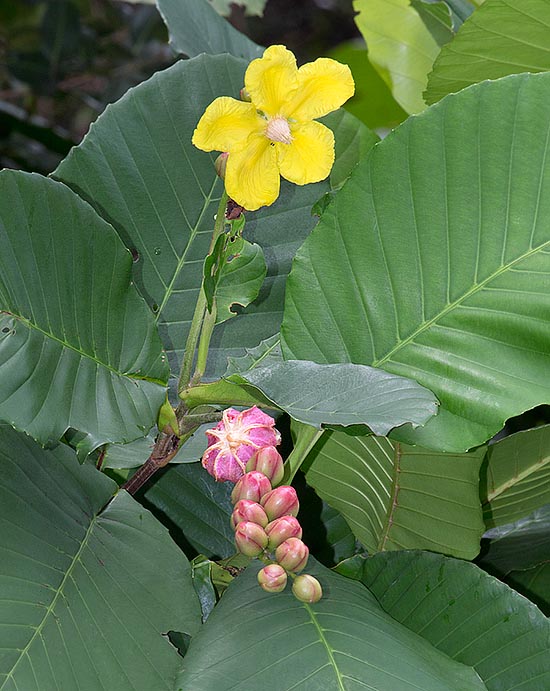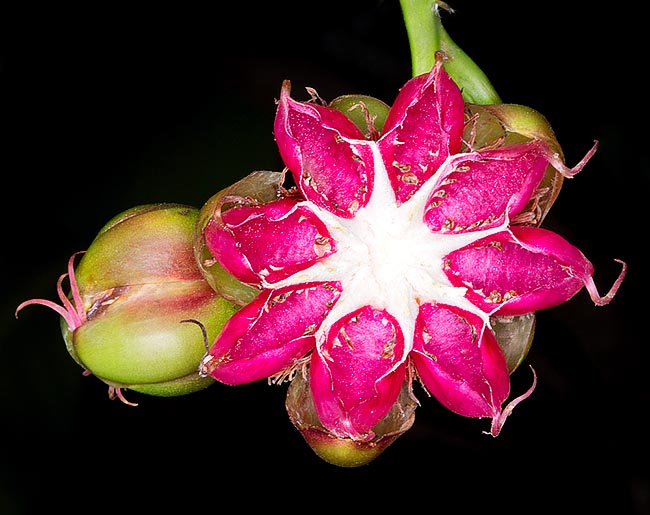Family : Dilleniaceae

Text © Pietro Puccio

English translation by Mario Beltramini

Dillenia suffruticosa is a 2-6 m shrub native to Indonesia, Malaysia and Singapore. 8-10 cm corollas and pink ellipsoidal fruits with 7-9 carpels that open to offer the seeds to the birds. Easy to cultivate as ornamental plant in the tropical gardens. Medicinal properties © Giuseppe Mazza
The species is native to Indonesia (Kalimantan and Sumatra), Malaysia and Singapore where it grows in various habitats, at the margins of the forests, among the mangroves, in swampy areas, along the banks of the water streams and on the sand, from the sea level up to about 500 m of altitude.
The genus is honoured to the German botanist Johann Jacob Dillen (Latinized in Dillenius) (1687-1747); the specific name is the Latin adjective “suffruticosus, a, um” = suffruticose (it is said of a pernnial plant, low, with lignified basal branches and herbaceous upper ones).
Common names : shrubby dillenia, shrubby simpoh (English); simpor, simpur (Brunei); plo sbat (Cambodia); abuan, simpoh, (Indonesia); simpoh air, simpor bini, simpoh gajah (Malaysia); diyapara, godapara, para (Sri Lanka); san yawa (Thailand).
The Dillenia suffruticosa (Griff.) Martelli (1887) is an evergreen shrub 2-6 m tall with leaves, on a 1,5-5 cm long winged petiole, simple, alternate, obovate to elliptic with slightly toothed margin and parallel lateral nervations prominent below, 15-35 cm long and 6-20 cm broad, coriaceous, of intense green colour and glossy above.
The inflorescence, on a 5-10 cm long peduncle, are usually simple, at times compound, subterminal racemes, bearing hermaphroditic flowers, of 8-12 cm of diameter, with 5 ovate, concave sepals, 1,5-2 cm long and 1 cm broad, initially green then suffused of pink and slightly bigger in fruit, persistent, 5 obovate petals with wavy margins, 4-5 cm long and 3 cm broad, of yellow colour, and numerous stamina.
The flowers open in succession one at a time, last only one day and are mainly pollinated by the bees. The fruits are pinky ellipsoid capsules opening on the plant usually in 7-9 segments (carpels), 2-2,5 cm long and 1-1,5 cm broad, to form a sort of star facing upwards, exposing the seeds, 1-4 per segment, of blackish colour and covered by a red fleshy aril, particularly appreciated by the birds who contribute to their dispersion.
It usually reproduced by seed, in draining loam maintained humid at the temperature of 24-26 °C, with germination times of 1-3 months and first bloming starting from the third year of age.

Close-up of the showy open fruit © Giuseppe Mazza
Amply diffused in the origin countries, where colonizes the uncultivated areas and the margins of the roads, has naturalized in many tropical countries, where has been introduced, becoming in some case invasive.
Often utilized in parks and gardens due to the huge flowers, produced almost continuously, the fruits and the foliage highly ornamental, ad isolated specimen, in group, or for barriers, eclusively in the tropical and subtropical climate zones. It requires an exposition in full sun and is not particular about the soil, even if poor and compact; pioneer species, grows also on the sand, thanks to the long taproot capable to reach the water in depth.
Due to the fast growth and its adaptability is at times utilized in the reforestation of degraded areas.
Cultivable even in pot, in organic loam with addition of sand or perlite per a 30% to improve the drainage, for the decoration of greenhouses and winter gardens particularly luminous, with lowest winter values of temperature above the 15 °C, regular waterings and fertilizations, in spring-summer, with balanced products with microelements. Locally the leaves are utilized for wrapping foods and parts of the plant in the traditional medicine; laboratory studies have evidenced the presence of bioactive compounds with promising antimicrobial, antifungal, antioxidant and anticancer properties. The species, finally, has been chosen as floral emblem of the Sultanate of Brunei.
Synonyms: Wormia suffruticosa Griff. (1854); Wormia burbidgei Hook.f. (1880); Dillenia burbidgei (Hook.f.) Martelli (1887); Dillenia suffruticosa var. borneensis (Ridl.) Ridl. (1913).
→ To appreciate the biodiversity within the DILLENIACEAE family please click here.
